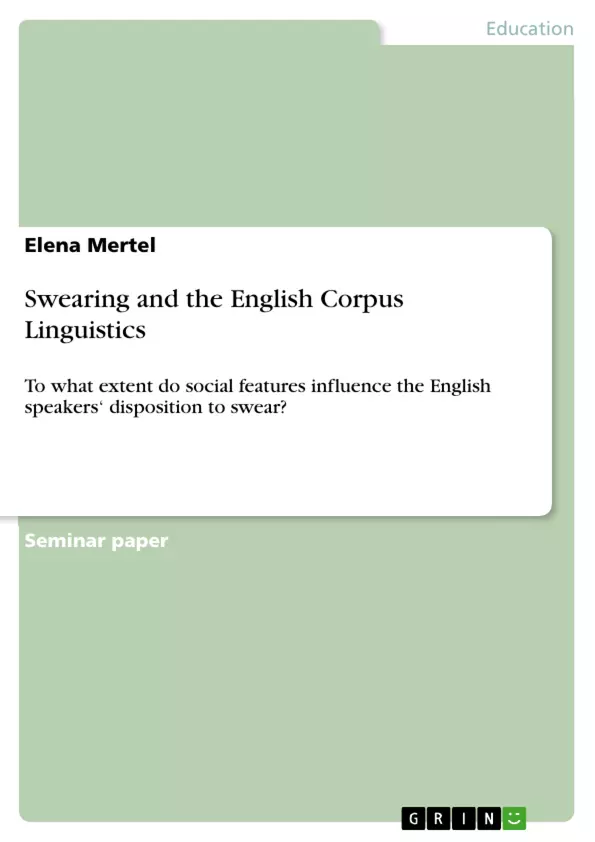This paper aims to examine today's representation of common curse words in a linguistic approach. I will have a look at five frequently used swearwords in the English language and evaluate those due to social features of the speaker and the addressee by using data from the BNCweb corpus.
In addition to that I will either prove or disprove some of the following assumptions made by Timothy Jay and Kristin Janschewitz for the circuit of the BNCweb corpus: “Swearing is influenced by pragmatic (contextual) variables such as the conversational
topic, the speaker-listener relationship, including gender, occupation, and status, and the social-physical setting of the communication with respect to whether the swearing takes place in a public or private location, one’s jurisdiction over the location, and the level of formality of the occasion.”
To narrow this down, I categorize my research in four classes: context, status, gender and additionally age. Finally, I conclude whether the above-mentioned social features influence a native English speaker's disposition to swear.
Inhaltsverzeichnis (Table of Contents)
- 1. Introduction
- 1.1 A Brief History of Swearing
- 1.2 Aim of this Thesis
- 2. Main part
- 2.1 Swearing and Context
- 2.2 Working with The BNCweb Corpus: A Selection of Swearwords
- 2.3 Swearwords and Status
- 2.4 Swearwords and Gender
- 2.5 Swearwords and Age
- 3. Conclusion
- 4. Works Cited
- 5. Appendix
Zielsetzung und Themenschwerpunkte (Objectives and Key Themes)
This thesis investigates the contemporary usage of common English curse words through a linguistic lens. It analyzes the frequency and context of five frequently used swearwords within the BNCweb corpus, examining their correlation with social features of both speaker and listener. The study aims to verify or refute existing assumptions regarding the influence of social factors on swearing behavior.
- The historical development and evolving understanding of swearing.
- The role of context in determining the appropriateness of swearing.
- The relationship between swearing and social status.
- The correlation between swearing and gender.
- The connection between swearing and age.
Zusammenfassung der Kapitel (Chapter Summaries)
1. Introduction: This introductory chapter provides a brief historical overview of swearing, tracing its development from early forms of emotional expression to its current multifaceted role in language. It highlights the diverse theories surrounding the origins of swearing and establishes the thesis's objective: to analyze the relationship between social features and swearing behavior using the BNCweb corpus. The chapter also introduces the key assumptions it will investigate, focusing on contextual factors, social status, gender, and age.
2. Main Part: This section delves into the core analysis, examining the interplay between swearing and various social factors. It begins by emphasizing the crucial role of context in determining the acceptability of swear words, exploring how different settings and relationships influence the use of offensive language. The chapter then uses the BNCweb corpus to investigate specific correlations between swear word usage and social variables such as status, gender, and age, laying the groundwork for the concluding chapter's evaluation of the study's findings. The diverse subchapters within this section offer a detailed breakdown of each factor.
Schlüsselwörter (Keywords)
Swearing, cursing, profanity, corpus linguistics, BNCweb corpus, social context, status, gender, age, pragmatic variables, linguistic analysis, emotional expression.
Frequently Asked Questions: A Linguistic Analysis of Swearing in Contemporary English
What is the main topic of this thesis?
This thesis uses corpus linguistics to investigate the contemporary usage of common English swear words. It analyzes how frequently these words are used and in what contexts, examining their relationship to the social characteristics of both the speaker and the listener.
What corpus was used in the analysis?
The analysis relies on the BNCweb corpus, a large collection of English texts, to examine the frequency and context of swear words.
Which swear words were analyzed?
While the specific swear words aren't listed, the thesis focuses on five frequently used curse words within the BNCweb corpus.
What are the key themes explored in the thesis?
The key themes include the historical development of swearing, the influence of context on swear word usage, the relationship between swearing and social status, the correlation between swearing and gender, and the connection between swearing and age.
What is the objective of this thesis?
The thesis aims to verify or refute existing assumptions about how social factors influence swearing behavior.
What social factors are considered?
The thesis examines the influence of social status, gender, and age on swear word usage.
How is context considered in the analysis?
The thesis emphasizes the crucial role of context in determining the acceptability of swear words, exploring how different settings and relationships affect the use of offensive language.
What does the introduction chapter cover?
The introduction provides a brief history of swearing, outlines the thesis's objective, and introduces the key assumptions to be investigated.
What does the main part of the thesis cover?
The main part delves into the core analysis, examining the relationship between swearing and social factors like status, gender, and age using data from the BNCweb corpus.
What keywords are associated with this thesis?
Keywords include swearing, cursing, profanity, corpus linguistics, BNCweb corpus, social context, status, gender, age, pragmatic variables, linguistic analysis, and emotional expression.
What does the conclusion chapter cover?
The conclusion chapter evaluates the findings of the study based on the analysis presented in the main part.
- Citation du texte
- Elena Mertel (Auteur), 2015, Swearing and the English Corpus Linguistics, Munich, GRIN Verlag, https://www.grin.com/document/464320



